Kira Lapinsky is a graduate student in the joint M.A. in Art History and Museum Studies Certificate Program. Kira and fellow Art History graduate students Floris Lafontant and Theresa Nelson were awarded a University of St. Thomas Graduate Team Research Grant to research street art with Dr. Heather Shirey this summer.
At a time when our nation is wrestling with the topic of immigration, it is more important than ever that we seek to understand experiences and perspectives outside of our own. How, then, can an examination of mural art produced in immigrant communities broaden and deepen our understanding of American identity, helping us to see beyond the experience of the dominant culture? This was one question my mind kept returning to during three trips funded by a St. Thomas Graduate Team Research Travel Grant. On trips to Philadelphia, Boston, and Chicago, I examined murals in each city’s Chinatown; I chose a mural in each of these cities to compare with Flows of Interconnected Motifs, the Hmong mural installed in 2017 in downtown St. Paul. The Hmong mural, I discovered, is atypical to the murals I encountered in the Chinatowns around the United States, but it still spoke a similar message of history, hardship, and community from the Asian immigrant perspective.
The murals in Philadelphia, Boston, and Chicago were made for their Chinatown communities. Realistic in style, the focus of each of these murals was the history of the Chinese population within that city. Typically, there were small vignettes showing experiences or places that meant a lot to the Chinese community—whether that was related to food, protests that took place, or picturing members of the community—everything traced back to the Chinatown identity. These murals continue to hold significance today because many Chinatowns throughout the U.S. are subject to urban development that is not for the benefit of the immigrant population—Chicago being the exception. The murals can serve as their claim to a small part of the larger community that they have staked out as their own; it’s a way of preserving the past and moving into the future—letting the larger community know that Chinatown still belongs to the Chinese.
The mural in Philadelphia, History of Chinatown, depicts the work and struggles of Chinese immigrants to Philadelphia: Chinese agriculture workers in the upper left corner wave to Chinese laborers who have come to America to build the railroad that emerges on the right side; these two groups frame a giant laundryman, shown wringing out a cloth, who represents the founder of Chinatown; the highway that makes up the bottom half of the mural represents the construction of the expressway that the Chinese community fought to stop (and they won); a family sits around their kitchen table holding out cups of tea, appearing to “cheers” the viewers.
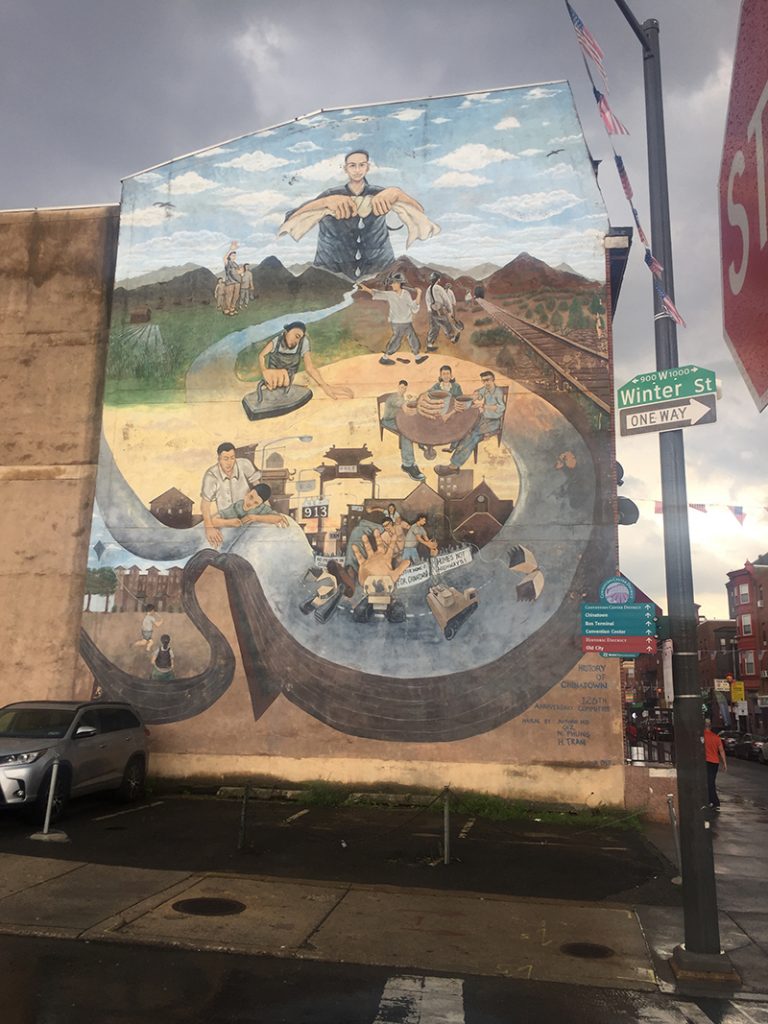
History of Chinatown, Arturo Ho, Giz, N. Phung, and H. Tran. Philadelphia, PA. Photographed July 12, 2018.
In Boston, the mural Tied Together by a Thousand Threads features small scenes of both the history of Chinatown and everyday stories of Chinatown residents. On the left side a near life-size rendering of a grandmother and her grandson blow bubbles that contain various scenes having to do with Chinatown, including the immigration raid of 1903, a dim sum spread, and seamstress (again, a nod to the laundry business that many Chinese immigrants took part in).
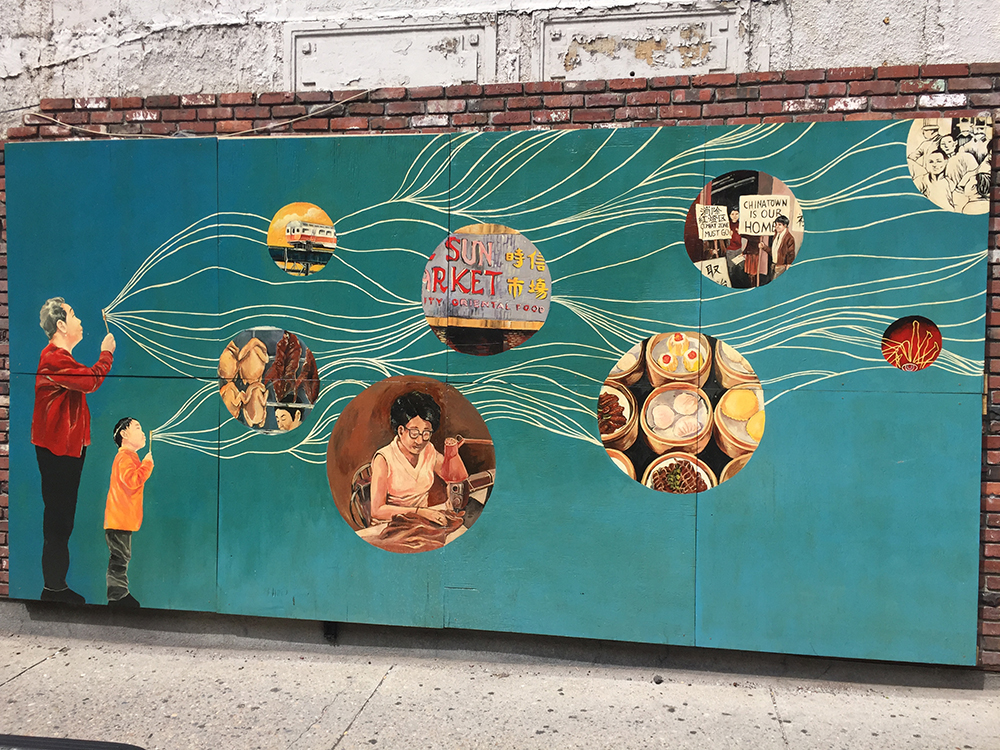
Tied Together by a Thousand Threads, Yvonne Ng. Boston, MA. Photographed July 29, 2018.
Similar to Boston’s mural in showing small scenes of their Chinatown’s past and present is Chicago’s mural, The Golden Age/The Beautiful Future. The mural was created on a bridge underpass, so existed on either side of a road while maintaining a continuous narrative. It included small circular elements of photographs (40 total) showing the history of the Chinatown community. The mural utilized a multimedia approach with mosaic tiles winding their way along one side of the underpass and continuing on the other, culminating in a large, 3D, painted dragon head with the mosaic having made up the body of the dragon. It was by far the boldest mural in my case study.
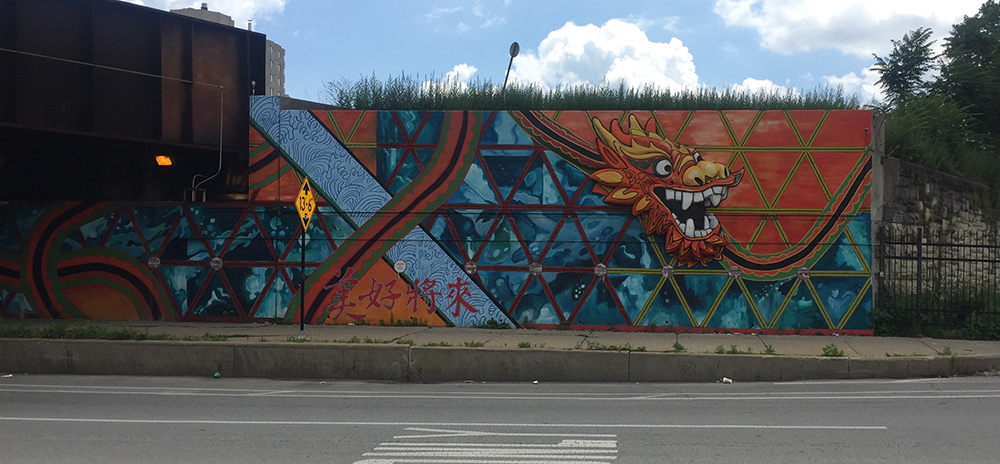
The Golden Age/The Beautiful Future, Andy Bellomo and Bernard Williams
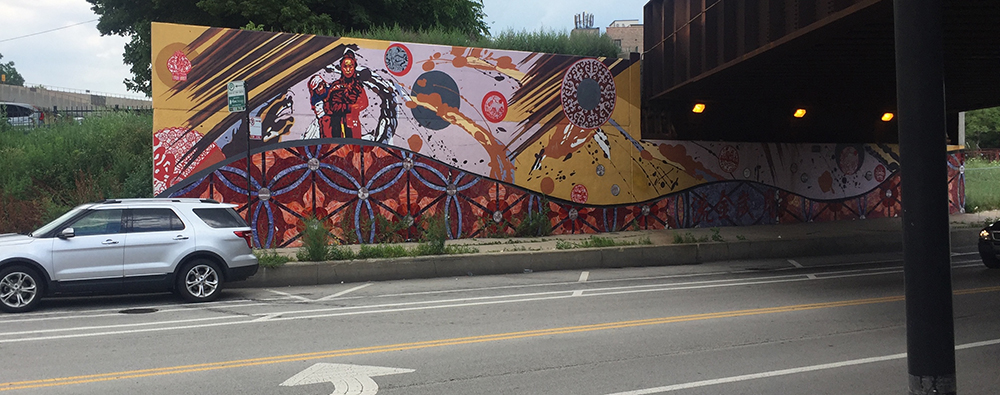
Chicago, IL. Photographed July 15, 2018.
Flows of Interconnected Motifs in St. Paul involved a group of local Hmong artists led by a Hmong artist from Australia. Each artist chose their own symbol that they felt connected to their community and cultural history and painted it in the same colorful, geometric camouflage pattern which represented Hmong story cloths. The symbols, which included frogs, honeybees and poppies, and a healer figure, represent the resilience of the Hmong community through hardship, their agricultural history, and one prominent role of Hmong women within their community, respectively.
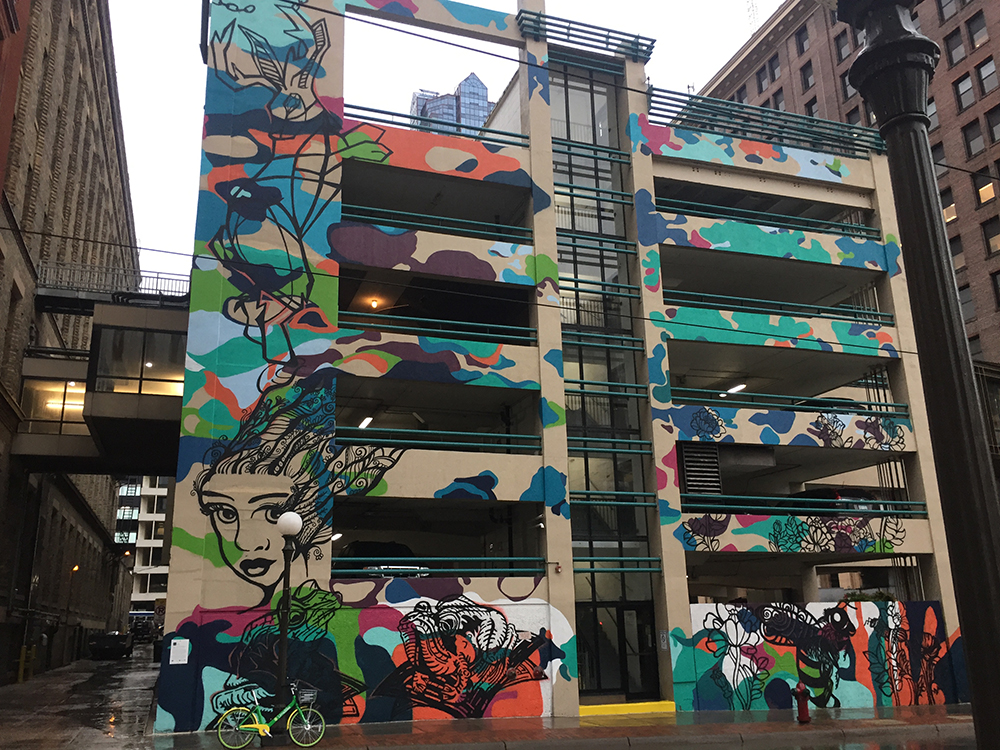
Flows of Interconnected Motifs, Vanghoua Anthony Vue, Xee Reiter, Christina Vang, Melissa Vang, Nicollazzi Xiong, and Shoua Yang. St. Paul, MN. Photographed September 20, 2018.
Interestingly, the mural in St. Paul is atypical from the Chinatown murals. This likely stems from many factors, not least of which is that the St. Paul mural was made for the city’s large Hmong population, not a Chinese one. The Chinatown murals had several commonalities: they were didactic, historically-focused, and realistic; they also were located within the immigrant populations’ primary living area rather than in the larger city. The Hmong mural is not overtly historically-focused, not located within the “Frogtown” neighborhood where the majority of the Hmong population in the Twin Cities is located, and it is more abstract in style. The reasons for these differences could be due to any number of factors: its placement outside of an immigrant community, therefore affecting its audience plays a large role; stylistic preferences of the artists certainly could account for some difference; the fact that it is a Hmong mural rather than Chinese surely matters.
In spite of these differences, however, I found that the murals did have similar stories to tell, even if they did so in divergent ways. The Chinatown murals in Philadelphia, Chicago, and Boston and the Hmong mural in St. Paul, were representations of the Asian immigrant story—one that is often forgotten about, ignored, or unheard. Their pasts as laundrymen, railroad builders, and agriculturalists were put on display; the hardships their communities have endured over the years, in the realm of politics or in urban development, were told, as both reminders to their younger community members and warnings to outsiders. The murals also often connect the immigrant community’s story to that of the larger community, both emphasizing the unique history of the immigrant community while also securing its place within the city it calls home.